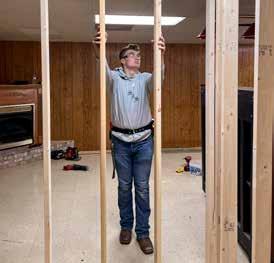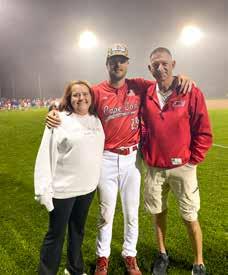Veterans benefit from telehealth space

MAJOR LEAGUER

Veterans benefit from telehealth space

MAJOR LEAGUER
Every day I hear examples of how the fast, reliable internet service provided by NTCA members brings telemedicine, rich entertainment resources, educational opportunities, jobs and far more to rural communities like yours.
But that’s just the beginning. These internet networks also create a vital foundation needed by a range of industries critical to the nation’s economy. While agriculture might not immediately come to mind when considering the internet, the $4.4 billion ag tech market is a showcase for how broadband can bring farms and ranches the internet-connected tools that make agriculture more efficient, productive and sustainable.
Smart irrigation systems, farm management and automation software, drones and sensors that can remotely monitor factors such as soil moisture are just a few of the innovations used in modern agriculture. They make a real difference, too.
For example, consider just one part of the agricultural equation — water. Leveraging these high-tech tools can reduce water use by 4%. When considering the scope of the industry, that’s a tangible difference, the equivalent of filling 750,000 Olympic-sized swimming pools.
Without reliable internet access, these tools wouldn’t be possible, nor would the benefits to consumers. When agricultural production is less expensive and yields are higher, we can all enjoy more favorable prices.
So, when you think about all your internet service provider does for you personally, take a moment to appreciate they’re making a difference for all of us, nationwide.
Internet-connected technology makes a bottom-line difference in agriculture, responsible for as much as an 8% increase in the value of corn crops alone. That’s an attention-getting result, and it makes it worth a closer look at ag tech.
Ag tech includes smart irrigation farm management software, drones, remote sensing, biotech, automation and more. Many of these tools rely on the internet to share access and store and share data.
Value of the U.S. ag tech market:
$4.4 billion
Value of agriculture, food and foodrelated industries: $1.26 trillion
Agriculture supports 43 million jobs, $2 trillion in wages and generates $718 billion in taxes.
9% reduction in chemical use
6% reduction in fossil fuel consumption
4% reduction in water use — enough to fill 750,000 Olympic-sized swimming pools
30-million-pound decrease in herbicide use
THE BOTTOM LINE: Ag tech enables farmers to lower costs while increasing yield and productivity.

After an exhausting workday, heading to that boring fitness class that’s way too expensive to skip sounds like about as much fun as a root canal. What if you could just click an app or website and join a class from home? Think of the time, energy and frustration you could save.
With live and prerecorded classes and a fast and reliable internet connection, it’s easy to turn any space into a gym. Thanks to apps and an array of online workout programs, you have the ability to exercise whenever, wherever and with whomever you want.
Some apps create personalized daily workout programs, while others provide a library of on-demand classes. Take a live class and become part of a community where everyone feels the burn.
As the popularity of online exercise programs continues to grow, so does the number of available options. Before choosing one, here are some factors worth considering.
Cost: Pricing can vary widely, but many apps and programs offer a free trial before requiring a subscription or financial commitment.
Instructors: Check their credentials to make sure they’re certified in whatever they’re teaching.
Variety: You’ll maximize your results by
finding a program that keeps you interested while increasing the difficulty over time.
Devices: Make sure the program you choose works across all your devices. Compatibility is important since one of the biggest benefits of online fitness is the ability to take it with you anywhere.
While the at-home workout might seem isolating, it’s actually a gateway to a digital community of like-minded fitness enthusiasts. The classes can provide a connection to a new whole world.
Onepeloton.com: Most famous for its much-advertised, in-home bike revolution, the Peloton digital app features on-demand and live classes of all kinds — no equipment needed.
Nike.com/ntc-app: This free app provides a variety of classes and styles for folks with busy schedules.
Apple.com/apple-fitness-plus: These classes, including yoga and Pilates, are personalized and perfected for Apple Watch users.
DailyBurn.com: This site offers the opportunity for one-on-one instruction. You can discover a favorite series or search for a specific workout depending on your mood.
Beachbody.com or BODi: This platform features ’80s-style bootcamp classes, progress-tracking and nutrition hacks.
Some mobile fitness fans are turning to more creative ways to work out at home. Harkening back to the days of Richard Simmons and Jazzercise, online dancing is fast becoming a personal fitness staple.
Online dance classes can be less expensive than in-person sessions and offer more style options. And, many people feel more comfortable staging a dance party in their own living rooms rather than in a studio full of strangers.
Zumba.com: The Latin-inspired cardio workout has motivated millions around the world to get moving since dancing into the spotlight in 2001.
Obefitness.com: With more than 8,000 classes and 20 different class types to choose from, there’s something for everyone. Up to 22 live classes are available, seven days a week, starting at 6 a.m. Eastern time.
Dancio.com: Here you’ll find hundreds of recorded classes covering various dance styles.
Steezy.co: Work out while learning a variety of urban dance moves.
There is nothing like a fire alarm at 2 a.m. to get the heart pumping. Thankfully, it was a false alarm, but we will get to that in just a moment. There is no sense in rushing the story.
 FRED JOHNSON Chief Executive Officer
FRED JOHNSON Chief Executive Officer
I am really proud of our security products and the people who maintain them. They are really good. But mechanical things may sometimes malfunction. Fire detectors are no exception. False alarms may occur. These are teachable moments. We must not let a learning opportunity go to waste. Wow! Didn’t that sound positively eloquent? Before I share my lesson, however, a disclaimer is appropriate. Parts of this story were redacted. They are not essential. That my wife is still laughing hysterically over them is immaterial. She is not allowed to discuss it. Do not ask her questions. Let us move on.
First, the siren is different for fire than for a break-in. Of course, it helps to know this in advance. The alarm panel will indicate the source, but you must be able to read it to appreciate that fact. This brings me to point two. If you need glasses, don’t forget to put them on. Third, it is really difficult to retrieve glasses, a gun and a fire extinguisher, all at the same time. I do not recommend trying it, especially at 2 a.m. Fourth, the monitoring station will call you within seconds regardless of the nature of the crisis. Do keep in mind that should there be either a fire or an invader in your home, it is not necessary to answer the phone. That will all take care of itself. Finally, I was reminded of what I already knew. The sounding of an alarm is not the appropriate time to design an effective response plan. Probably, you should do that ahead of time. I’m just saying. Given that FTC’s Emergency Response Plan is quite exhaustive and well-exercised, you should have expected my in-home plan to be stellar. Not so much. Again, this is a subject you should not discuss with my wife.
OK, seriously now. House fires are exceedingly rare, but they do happen. So do tornadoes and burglaries. There is no harm, yet a truly great benefit, in mapping out how you would respond in the event of any such occurrence. It really isn’t that hard. The key is to determine who does what in a given scenario and practice it. For example, should you need to evacuate, a light piece of luggage you can grab on the way out, containing a change of clothes and everything you would need for a couple of days of emergency lodging, would go a long way. Keep keys and other essential items in an easy-to-reach place. Our systems can provide needed warnings, and a little planning can make these critical seconds count. The information at ready.gov is really cool and goes a long way in helping you plan. I invite you to check it out. You might even have a little fun in the process — just preferably not in the middle of the night.
Connected is a bimonthly magazine published by Farmers Telecommunications Cooperative, © 2024. It is distributed without charge to all customers of FTC.
FTC is the state’s largest member-owned provider of telecommunications services. It serves Northeast Alabama with a robust broadband network using world-class optical fiber technology.
Farmers Telecommunications Cooperative, Inc.
P.O. Box 217 • 144 McCurdy Ave. N. Rainsville, AL 35986
Telephone: 256-638-2144
www.farmerstel.com
Randy Wright, President Flat Rock Exchange
Garry Smith, Vice President Fyffe Exchange
Danny R. Richey, Secretary Geraldine Exchange
Lynn Welden, Treasurer Bryant Exchange
Kenneth Gilbert Pisgah Exchange
Gregg Griffith Henagar Exchange
Randy Tumlin Rainsville Exchange
Produced for FTC by:
On the Cover:

FTC worked with the DeKalb County Veterans of Foreign Wars to obtain a grant for a space veterans can use for telehealth visits. See story Page 8.
Farmers Telecommunications offices will be closed on March 29 for Good Friday. The FTC technical support team is available to assist customers 24/7 at 866-638-2144.

Register online at www.donotcall.gov or call 888-382-1222.
For TTY, call 866-2904236. You must call from the telephone number you wish to register. Add your residential and wireless numbers to the Do Not Call Registry. The National Do Not Call Registry can drastically reduce the number of telemarketing calls you receive.
You also may register, or obtain additional information, via the Internet at www.donotcall. gov. You can also remove your number from the list at any time. If you’ve already added your phone number to the Do Not Call Registry and are still getting a lot of unwanted calls, odds are its scammers.
Even though the Registry can’t stop all of the unwanted calls, being on the Registry could make it easier for you to spot scam calls.
• If you suspect an illegal robocall, hang up. There’s a good chance it’s a scam.
• Do not answer unrecognized numbers.
• Don’t press buttons to be taken off a call list or to talk to a live person.
• Never engage with an unknown caller.
Instead, report it to the Federal Trade Commission. Learn more at ftc.gov/robocalls.
Farmers Telecommunications Cooperative Inc. and Farmers Telecommunications Corporation (collectively, “FTC”) want you to understand your rights to restrict the use of, disclosure of and access to your Customer Proprietary Network Information, or CPNI. You have a right and FTC has a duty, under federal law, to protect the confidentiality of your Customer Proprietary Network Information.
It is the information that FTC obtains that relates to the quantity, technical configuration, type, destination, location and amount of use of the telecommunications services you subscribe to from FTC, including broadband internet access service (“BIAS”). It includes the information that is found in your bills, but it does not include subscriber list information (name, address and telephone number).
Examples of CPNI would be the telephone numbers that you call, the times you call them, the duration of your calls or the amount of your bill. Certain information relating to your use of our BIAS will also be considered CPNI and subject to additional privacy protections and use restrictions, including your broadband service plans, geographic location information, MAC and IP addresses, domain name information, device identifiers, traffic statistics, port information, application headers, usage and payload, and certain consumer devices capable of connection to broadband services, such as smartphones, tablets, computers, modems and routers.
CPNI may be used by FTC to market services that are related to the package of services to which you currently subscribe, when providing inside wiring installation, maintenance and repair services and when marketing “adjunct to basic” services, such as call blocking, call waiting and caller ID.
CPNI may also be used for the provision of customer premises equipment (“CPE”) and services like call answering and voicemail or messaging, and to protect company property and prevent fraud. A carrier may use CPNI to bill and collect for the services you receive from FTC. FTC offers additional communications-related services. We seek your approval to access your CPNI so that FTC can provide you with information on new services and products that are tailored to meet your needs or may save you money.
IF YOU APPROVE OF OUR USE OF YOUR CPNI AS DESCRIBED ABOVE, NO ACTION IS NECESSARY ON YOUR PART.
You have the right to disapprove this use of your CPNI by contacting us in writing at P.O. Box 217, 144 McCurdy Ave. North, Rainsville, AL 35986, or by telephone at 256-638-2144 or toll free at 866-638-2144, within thirty-three (33) days after this notice is sent to you. Our drop box located at 144 McCurdy Ave. North, Rainsville, AL, is accessible twenty-four (24) hours a day, seven (7) days per week.
If you disapprove of our use of your CPNI, you may not receive notice of new services or promotions, but your existing services will not be affected. If you do not notify us of your objection within thirty-three (33) days, we will assume you do not object and will use your CPNI for these purposes. You have the right to notify us at any time to object to the use of this information. Your election will remain valid until you notify us otherwise.
 Story by KATHY DENES
Story by KATHY DENES
The Southeast boasts plenty of beautiful scenery, but the heavens get credit for two of the region’s most spectacular sights in a span of less than six months. For three hours on Oct. 14, an annular eclipse created a “ring of fire” visible along its path from Oregon down through Texas. April 8 will bring yet another eclipse, this time plunging all beneath its route from Texas up to Maine and beyond into total darkness.
Except for Southwest Kentucky, very little of the Southeastern U.S. will be in the path of totality. The shadow will barely hit the northwest corner of Tennessee as it cuts through the Kentucky Band region, skims Mayfield and then darkens Paducah and Henderson around 2 p.m. EDT.
For those not in the path of totality, even the partial eclipse will be awesome to behold. Starting around 1:55 p.m. in areas east of totality, the orbiting moon will obscure the sun’s bottom-right section and make it look like a crescent by around 3 p.m. By about 4:20 p.m., the sun will again be a complete ball of fire.

“And the moon in haste eclipsed her, and the sun in anger swore.”
— Aristophanes, Greek writer, 450-385 B.C., after observing an eclipse

ECLIPSE 101
TOTAL ECLIPSE: When the moon passes between the Earth and the sun and briefly covers the sun’s disk completely, areas within the narrow path of the moon’s shadow will experience total darkness. Those outside the path of totality will see a partial eclipse. Go to greatamericaneclipse.com or eclipse2024.org to see how the eclipse will look in your area and to find loads of other information.
VIEWING AN ECLIPSE: The only time it is safe to look at the sun with the naked eye is during the brief totality phase of a total solar eclipse, so that only applies to those directly in its path. At all other times, eclipse phases and locations, direct viewing of the sun is only safe through special solar filters and viewers. Look for the ISO 12312-2 standard, and make sure they are free of scratches or flaws. No. 13 or 14 welder’s glass also provides protection.
Events for seeing and celebrating the eclipse include Paducah’s two-day downtown street fair and a viewing party at its National Quilt Museum. Louisville’s Kentucky Science Center is chartering buses to take eclipse fans to Evansville for a riverfront view of totality.
U.S. Space & Rocket Center in Huntsville, Alabama, home to the INTUITIVE planetarium, is setting up solar telescopes. Many educational activities are planned, including NASA’s livestream of the eclipse which will be shown throughout the center.

Of the 350-plus permanent planetariums in the U.S., six are in Alabama, eight in Kentucky, four in South Carolina and five call Tennessee home. Find one near you at go-astronomy.com/planetariums.htm.
 Photo by supertramp8/Adobe Stock Illustration by Andramin/Adobe Stock
Photo by supertramp8/Adobe Stock Illustration by Andramin/Adobe Stock

With FTC’s help, DeKalb County VFW opens a room for telehealth visitsStory by JEN CALHOUN
When the U.S. Department of Veterans Affairs started increasing its use of telehealth visits during the COVID-19 pandemic, local veterans’ organizations quickly realized the coronavirus wasn’t their only problem.
“We had these veterans who were trying to see their doctors, but they didn’t have the computer knowledge or the internet access to handle a telehealth visit,” says Eric Dudash. Eric is the former commander of DeKalb County Veterans of Foreign Wars Post 3128, and he’s the current senior vice commander of the Department of Alabama VFW.
Around that time, FTC representatives Brandi Lyles and Kim Williams stepped up with an offer to help. By securing a Virtual Living Room grant from the Foundation for Rural Service and rounding up other resources, Eric learned FTC could help build a dedicated telehealth room inside the local VFW post.
The FRS Virtual Living Room grant program is part of a collaboration between the VA and NTCA–The Rural Broadband Association. The program is designed to address the needs of rural veterans in an increasingly technological age. It offers $5,000 grants to rural telecommunications organizations to help provide a comfortable and private space to access VA telehealth services for vets with

limited computer experience or those without a computer or internet service at home.
The soundproof, wheelchair-accessible room opened in February, and it is among the first in the state. All military veterans in the county — even those who are not VFW members — are welcome to use it. The room has all the equipment needed to connect veterans to any physician they need to see. VFW volunteers are also available to provide tech support and expertise, as needed.
“It is always a pleasure to work with our local VFW. We can never repay these veterans for all they have done and continue to do for each of us,” says Brandi, executive vice president of marketing and public relations at FTC. “This telehealth office is one simple way to provide a valuable resource to our local veterans that will give them access to more convenient healthcare and helpful online resources to improve their lives. We are forever thankful for our veterans.”
In addition to the $5,000 FRS grant, Brandi at FTC worked with DeKalb County Schools to enlist the help of the DeKalb County Career Technology Center. Zane Dalton, a certified contractor and the school’s building construction teacher, took it from there.
Over several days, a team of juniors and seniors from various DeKalb County high schools constructed, wired and installed trim in the 10-by-10-foot room they designed. “It felt really good to help our veterans out,” Zane says.
The VFW post and FTC split the building materials cost, making it a true community project, says Colt Drouillard,

the post’s commander and the state VFW surgeon, who coordinates veterans’ health information. “FTC also bought the furniture, and they decorated it for us,” Colt says.
“There are not many VFW posts around the country doing this, but we were just blessed to have FTC as a partner,” Eric says. “They’ve always said they cared about veterans. They put action into words, and that means so much. We can’t thank them enough.”
With the rising demand for physical and mental health care within the military community, creating a central location for vets to access that care and community became a true need, Colt says. DeKalb County is home to nearly 3,400 veterans of all ages, although more than 40% are between the ages of 18-34 — a group that’s particularly vulnerable to suicide, according to statistics gathered by Post 3128 from the VA and the U.S. Census Bureau.
Trips to the nearest VA hospitals and clinics can take a full day when travel time is factored in, Eric says. “The big hospitals and centers with all the specialists are either in Chattanooga, Birmingham, Guntersville, Huntsville or Montgomery,” he says. “Even if I go to a regular VA doctor in Gadsden, that’s up to an hour drive for me, one way.”
The new space also helps cement the DeKalb County post as a place where veterans can feel comfortable and get the support they need. “I spent 30 years in service, and nothing prepares you to be transitioned correctly,” Eric says. “When people hear ‘VFW,’ they don’t think of it as a resource that helps in transition. They

think of a smoky, old bar, and that couldn’t be further from the truth here.”
In fact, Post 3128 does not have a bar at all, he says. Very few of Alabama’s VFWs include bars anymore. “Almost 70% of our VFWs are bar-free and family-oriented,” Eric says. “To get this message out, we hold our annual county fair, and we advertise during the June Jam concerts.”
The post donates the use of its grounds to the community for various events. It also hosts Race to Embrace, a 5K that benefits children, and offers flu and COVID-19 vaccination clinics. “It’s that kind of VFW,” Eric says. “Hopefully, all those things — and now the telehealth room — will show other vets this is a place they can come to. It’s a place where they know we care.”
151 18th St., Fort Payne 256-845-5466
Follow the DeKalb County VFW Post 3128 on Facebook, Instagram, X and Threads.



Seven-year-old Turner Holland wanted to keep busy outside of school, but he knew he wasn’t athletic and couldn’t stand sports. That’s when his dad, Joe, brought home a half-dozen baby chickens from Tractor Supply.
Those first six chicks led to hundreds more as Turner and his family jumped into the world of backyard poultry at their home in Harrodsburg, Kentucky. Now known as Chicken Hill Farm, they are a go-to source of the rare blue Araucana, as well as several other breeds of ornamental chickens. Their clientele is a growing group that finds joy in raising chickens. More than 12 million people — about twice the population of Arizona — share their yards with a flock, according to The American Pet Products Association’s most recent national pet owner survey. The number of households with chickens rose from 8% in 2008 to 13% in 2020.
Many people choose to keep them as pets or as a steady source of fresh eggs.
But exhibition chickens like the Hollands’ are often inconsistent layers. Instead, these flashy fowls have a different job — strutting their stuff.
bantams are Turner’s favorite chickens to breed and show.
The Hollands’ signature Araucana chickens are recognizable by their poof of feathers — known as tufts — that grow at their ears instead of at their “rumpless” tail ends. While the “hilarious, friendly girls,” known for their pastel blue eggs, are Chicken Hill Farm’s stars, they share the spotlight with many other funky chickens. There’s the Muppet-like jet black Polish with their explosion of fluffy, white head feathers that often obscure their eyes. The Brahmas have abundant, soft feathers that cover their legs and feet. And then there are the small silkies, the most unique of all. Lacking the barbicels that hold a feather’s shape, they look — and feel — like they’re covered with fur rather than feathers.
Maintaining the chickens’ genetics is fascinating, says Turner’s mom, Meagan.

At first, she and Turner focused on breeding, but then they discovered the exhibition part of fancy poultry. They took a few of their favorites to a local county show in June 2022 and then to another one a week later. Turner is now 11 and a rising star on the exhibition poultry circuit.
“After that, it just snowballed, and he’s all in,” Meagan says. “He just fell into it and is obsessed. This is such a great activity for him and for us to do as a family.”
The family now spends most weekends in the summer and fall traveling to exhibitions where Turner is making a name for himself. Meagan handles the birds. Joe, an Army veteran, drives. And younger son, Kaiser, is beginning to join his brother in the show ring.
“I don’t know if my husband was as excited about our new lifestyle,” Meagan says with a laugh. “He’s not into the breeding like Turner and I are. But he enjoys the birds and the time we spend together as a family.”


Saving money and healthier eggs are the intent of many people who raise chickens, but those goals are often difficult to reach, says Gregory Archer, associate professor and extension specialist for Texas A&M Department of Poultry Science.
“I tell people it should be more about self-satisfaction and the desire to know exactly how and where your eggs came from. Chickens are also fun, and kids love them.”
Possible challenges include bird medical care, waste management or strategies for excess eggs. Similarly, predators can quickly be an issue.
Also, there are geographic-specific considerations. “Often, people don’t manage heat or get the correct breeds for Texas heat,” he says. “You need to make sure you have fresh water, shade and maybe some fans.”
A little research will help identify birds suitable for heat, cold or any environment.

If you’re contemplating backyard chickens, consider these points before adopting the chicken lifestyle.
• Check for the latest rules on chicken ownership in your town and county. Many cities limit the number of chickens allowed per household and prohibit roosters entirely.
• Often, cities require chickens to be kept enclosed and that the coop is well maintained and cleaned frequently.
• If you decide to sell your eggs, ensure it’s legal where you live.
Even small-scale chicken farming requires ongoing expenses after buying or building a coop and fencing.
• A 40-pound bag of feed can cost $25 or more, depending on the brand, nutritional value and other factors.
• Dietary supplements are typically needed, so budget for extra proteins and treats, like dried insects — a 5-pound bag can cost at least $50.
• Chickens require fresh bedding, like pine shavings or chopped straw, every time the coop is cleaned.
While caring for chickens isn’t a full-time job, do expect to invest time.
• Most people adopt a daily or twicedaily routine for feeding and watering.
• Many times, chickens need to be let out of a small coop in the morning and herded back in at night for safety.
• Remember, chickens can fly. Some people prefer to clip their wings regularly, while others choose a run with fencing or netting overhead.
Source: Osceola County Extension Agent Jessica Sullivan

Jake Peppers, standing beside a bucket full of baseballs, made the mound his happy place. Sometimes the sun blazed down, other times, he shivered from the cold. But no matter the season, he practiced pitching at Geraldine High School’s baseball field.
“Coach Jamie Gilbert gave me a key and told me to pitch all I wanted to,” Jake says. “I still do it to this day.”
During high school, Jake worked to develop the skills needed to play in college. The effort paid off for the 2020 high school graduate — he earned a scholarship to Jacksonville State University. But that was only the beginning.
Last July, Jake received the call that just about every kid who ever played Little League dreams of. The Chicago White Sox selected the 6-foot-3-inch pitcher in the ninth round, on the second day of the Major League Baseball draft.
After speaking with his agent, Jake expected to be drafted. The timing and the team, however, were a mystery. Jake, his family and close friends watched the live draft selections on ESPN. When pick 269 came on the screen, the announcer called his name. “That was surreal,” Jake says. “It was a supercool moment, and we celebrated the rest of that day. It is something that I’ll never forget.”
From that moment on, life became a whirlwind. Jake learned he was booked on a plane leaving two days later for North Carolina and the White Sox affiliate that was the first stop for all signees. Practice, signing contracts and learning what to expect soon followed. Then, there was a flight to Glendale, Arizona, for work at Camelback Ranch, a top-level training site where he stayed for four weeks.
By mid-October Jake returned to his hometown, where he continued training. He also served as grand marshal of the Geraldine Christmas parade, and he prepared for his January wedding. He

was to report in February to Kannapolis, North Carolina, to join the Cannon Ballers, the Single-A affiliate of the White Sox.
Hoping to move up through the minor league system, he already has a goal — the Birmingham Barons. “My goal is to play well and move up,” Jake says. “I want to move up to Double-A as fast as I can, so I will be in Birmingham. That will be easier on my family and friends to come to the games.”
It’s important to Jake that his family and friends see him play. His parents, Mike and Jan Peppers, supported him from the first time he played T-ball at 3 years old. Like most small-town kids who love sports, Jake played them all. But on school assignments when asked what he wanted to be when he grew up, Jake always wrote professional baseball player. “He never had a doubt that it was going to happen,” Jan says.
Jake credits his parents for much of his success. “They always supported me in whatever I wanted to do,” Jake says. “They made a lot of sacrifices so I could play baseball.”
As he got older, Jake knew he needed to focus to achieve his dream. In addition to his school baseball team, he played travel ball, where his mentors made a difference. His first travel ball coach, Eddie Priest, had played for the Cincinnati Reds. Jake did
“IT WAS A SUPERCOOL MOMENT. IT IS SOMETHING THAT I’LL NEVER FORGET.”Jake Peppers

not pitch as much in those days, and his small stature had him often playing catcher or shortstop. “Coach Priest made every player learn every position and that was so helpful,” Jan says. “Jake was glad to be playing wherever he was needed.”
By his junior season, Jake had shot up to 6-foot3, and that extra height elevated the interest in him from college scouts. Jake had several offers, and he eventually chose JSU, attending on both athletic and academic scholarships.
 Sox
Sox


His success at JSU drew attention from the pro scouts. Which is reflected in how he’s described on the White Sox’s website, which calls him the best arm since 2009’s Minnesota Twins third-rounder Ben Tootle.
Growing up in a small town also taught Jake a lot, and he says his path to play professionally is different than that of kids who went to larger schools. The relationships he built and the encouragement from the Geraldine community helped him tremendously.
“From the time he was in the ninth grade, I knew he would be special,” says Jamie, Jake’s high school coach. “He is a natural athlete and could have played point guard on the basketball team,

Jake played in the Cape Cod Baseball League before the MLB Draft. He credits his parents, Jan and Mike Peppers, with much of his success.
Jake started playing baseball when he was 3 years old.
Jake played travel baseball as a kid, giving him even more experience to improve his game.
or he could have been the starting quarterback, but he focused on what he loved and that was baseball. He dedicated himself to working hard and pursuing his dream to play major league baseball.”
Jake loves his hometown and is proud to be from a small closeknit community.
“Jake loves his community,” the coach says. “And this community loves Jake. Our school and our community are so proud of Jake, and he’s special to us.”
— on being drafted by the Chicago White CLOCKWISE FROM TOP: Jake fulfilled a lifelong dream to play professional baseball when he was drafted by the Chicago White Sox.are key ingredient of America’s melting

Every local dish has a story behind it, history heaped with flavor. One of the best ways to discover these is by stirring the nation’s culinary pot to see what’s cooking.
Certain dishes are common to us Americans across the board. We’ll fry just about anything. From Twinkies to turkeys, they all go in the deep fryer. But, when it comes to comfort-food classics, states and regions have their own distinct accents. U.S. culinary traditions form a giant melting pot with regional flavors blended in for extra deliciousness.
Regional foods are some of the most fascinating bites one can experience. Here’s a look at some of the ones that are favorites across our nation.

Food Editor
Anne
P. Bralyis a native of Chattanooga, Tennessee.
Photography by Mark Gilliland Food Styling by Rhonda GillilandYou’d be hard-pressed to walk into a diner around the South and not see mac and cheese on the menu. This recipe just takes it up a notch.
1 pound short pasta, such as elbow macaroni or shells
1 pound smoked gouda cheese, grated
8 ounces extra-sharp white cheddar cheese, grated
1/2 cup (1 stick) unsalted butter
4 tablespoons all-purpose flour
2 cups heavy whipping cream
2 cups whole milk
1/2 teaspoon smoked paprika
1/2 teaspoon ground white pepper
1/2 teaspoon ground mustard
1 teaspoon garlic powder
1/4 teaspoon ground nutmeg
Salt, to taste
4 slices of bacon, crumbled (optional)
Preheat the oven to 350 F. Cook pasta according to package directions to al dente stage, then set aside.
In a large Dutch oven or other deep pot, heat butter over medium-low heat. Once butter has melted, add in flour and whisk until all flour disappears, then slowly add in heavy cream and whole milk. Stir and let mixture come to a slight boil. Add in all spices and stir again. Lastly, add in 8 ounces of smoked gouda cheese and white cheddar cheese. Whisk until all cheese has melted.
Add in pasta and mix everything together to fully incorporate, making sure all pasta is coated with sauce. Add salt, to taste.
Transfer mixture to a large, lightly greased baking dish, then top dish with remaining smoked gouda. Bake for 25 to 30 minutes or until mixture is golden and bubbly.
Let cool for 15 minutes and serve warm topped with crumbled bacon, if desired. Makes 8 servings.

Wild rice is found throughout the Midwest, where this recipe originates.
1 small onion, chopped
1/3 cup butter
1/3 cup all-purpose flour
1 1/2 teaspoons salt
1/2 teaspoon pepper
1 can (14 1/2 ounces) chicken broth
1 cup half-and-half
4 cups cubed, cooked chicken
4 cups cooked wild rice
2 jars (4 1/2 ounces each) sliced mushrooms, drained
1 jar (4 ounces) diced pimentos, drained
1 tablespoon minced fresh parsley
1/3 cup slivered almonds
Salsa is the condiment of choice throughout Texas and many of the Western states.
1 can (28 ounces) whole tomatoes, drained
1 can (14 1/2 ounces) diced tomatoes with garlic and onion, drained
1 can (14 1/2 ounces) stewed tomatoes (with Mexican seasonings, if you can find them), drained
1 can (10 ounces) diced tomatoes and green chilies, drained
1 medium onion, quartered
2 banana peppers, seeded and coarsely chopped
2 jalapeno peppers, seeded and coarsely chopped
3 garlic cloves, minced
2 teaspoons salt
1/4 teaspoon ground cumin
1/2 cup minced fresh cilantro
1/4 cup lime juice
2 ripe avocados, peeled and cubed Tortilla chips
In a large saucepan, saute onion in butter until tender. Stir in the flour, salt and pepper until blended. Gradually stir in broth. Bring to a boil. Boil and stir for 2 minutes or until thickened and bubbly. Stir in the half-and-half, chicken, rice, mushrooms, pimentos and parsley. Heat through.
Transfer mixture to a greased 2 1/2quart baking dish. Sprinkle with almonds. Bake, uncovered, at 350 F for 30-35 minutes or until bubbly. Makes 6-8 servings.

Place the first 10 ingredients in a food processor; cover and process until chopped. Add cilantro and lime juice; cover and pulse until combined.
Transfer to a bowl; stir in avocados. Serve with tortilla chips or use as a condiment for your favorite Tex-Mex dishes.
This is a popular recipe in the Northwest where fresh salmon is easy to find. In other states, try to get your hands on the freshest fish possible to bring out the flavors in this dish.
4 salmon steaks, 1 inch thick
All-purpose flour (for dredging)
1/4 cup plus 3 tablespoons butter, divided
3 tablespoons onion, finely chopped
1 clove garlic, minced
1 heaping tablespoon capers, drained
1/8 teaspoon dried Italian seasonings, crushed
1/2 cup white wine
2 tablespoons freshly squeezed lemon juice
2 teaspoons beef broth
Preheat oven to 400 F. Rinse salmon steaks under cool water, pat dry and roll in flour.
In a large ovenproof frying pan or saute pan, heat 1/4 cup butter until it melts. Briefly saute the salmon steaks, browning them lightly on both sides. Bake, covered, 10 to 15 minutes until a meat thermometer registers an internal temperature of 140 F, or until salmon is slightly opaque in the thickest part. You may need to cut to test. During this time the meat continues to cook because the meat temperature will rise 5 to 10 degrees after it is removed from the oven and the juices will redistribute. Remove from oven. Reserve liquid in the pan, and transfer salmon onto a warm serving platter.
Using the same pan over medium heat, stir into the reserved liquid the onion, garlic, capers and Italian seasonings. Simmer for 5 minutes. Add white wine, lemon juice and beef broth. Stir until well blended. Turn off the heat, whisk in the remaining 3 tablespoons butter until blended. Remove from heat, pour sauce over salmon and serve immediately. Makes 4 servings.

